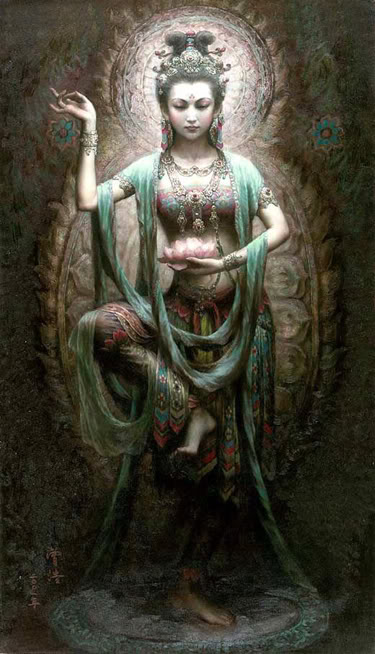Do you see the purple orb in the top right hand corner? Magick at work!
If you're looking for a ritual to celebrate Litha, I've added one to my 'Sabbatts and Esbats Ritual Pages'. It's a simple ritual that can be done in the great outdoors, but one that can also be done inside if required.Wishing you a Blessed and Happy Litha!
Showing posts with label birth of Sun God. Show all posts
Showing posts with label birth of Sun God. Show all posts
Saturday, June 18, 2011
Litha/Summer Solstice
Litha is the Sabbatt that is celebrated at the Summer Solstice. The Goddess is in her full pregancy ready to give birth to the God. It is the longest day of the year and it's about celebrating the power of the Sun. The crops are growing heartily and the earth is warm and inviting. It's a time to spend long sunny afternoons enjoying the outdoors and getting back to nature.I've created my Litha altar with reverence for the God and Goddess, but also with fun and frivolity in mind. Midsummer is a time to let your hair down, swim skyclad (if you're so inclined) and just enjoy 'being'.

Monday, January 31, 2011
Imbolg ~ February 2nd
Here in the northern hemisphere, most of us are still in the grips of winter. For our ancestors, snow covered the earth, the nights were still long, and the festivities surrounding Yule and the Solstice are long since past. Food supplies were beginning to dwindle and become moldy and the promise of spring seemed far away. Yet with all this, they still celebrated. In the cold darkness, they found reason for hope, thus creating a holy day, a festival, a feast.Imbolg became an important festival to the Celts who were pastoral herders. Imbolg (pronounced em-bowl/g) means 'in the belly' and refers specifically to the pregnant sheep and more broadly to Mother Earth who is beginning to show signs of life. Another name for this holiday was Oimelc which means 'ewe's milk', an important life sustaining beverage for the family. Because it was so important, an offering of ewe's milk would often be left overnight for the God/dess as a libation to encourage bounty.Imbolg is also considered a great fire festival with the emphasis on the light of the fire rather than on the heat it gives. The sun's light is noticeably with us longer each day and is our assurance that the Wheel is turning and that spring and summer will return.Other traditions observed during Imbolg are meditation and divinations to determine what a person should focus on magickally or spiritually for the year, writing poetry or weaving (crocheting for me) in honor of Brigit, rituals to ask Brigit or another personal diety for inspiration, or simply rituals of gratitude for the growing light. In many Wiccan traditions, Imbolg is also a time for initiation.Imbolg is about the first signs of spring, the promise of returning life, about sunlight and ripening and the growing conviction that the community will survive another year. Perhaps so but in my neck of the woods we're expecting up to 13 inches of snow with wind gusts of 40 to 50 miles an hour over the next two days. Spring may be on its way, but it sure is taking its damn time about it!
Have a blessed Imbolg!

Have a blessed Imbolg!
Labels:
birth of Sun God,
celebrate,
Feast of Brigit,
festival,
Imbolg,
ritual,
spring,
summer,
wheel
Tuesday, December 21, 2010
12 Days of Yule ~ Day 2
2nd Day of Yule – The Winter Solstice
December 21st
"The Winter Solstice represents the shortest day and the longest night. From this day onward Caillech Bheur gains strength and eventually breaks winter's spell. Celebrate Caillech's return and the fertility she brings!"Yule (from the Anglo-Saxon 'Yula', meaning 'wheel' of the year) is usually celebrated at the Winter Solstice. It is a Lesser Sabbat or Lower Holiday in the modern Pagan calendar, one of the four quarter-days of the year, but a very important one. This year it occurs on December 21st with the Solstice being at 5:38 p.m. Central Standard Time. Pagan customs are still enthusiastically followed ~ the burning of the Yule log, the drinking of Wassail, and lighting the tree (which in times gone by was lit with candles). It is a time for reverence, joy and celebration. On this beautiful and most celebrated of nights, the Mother Goddess gives birth to the Sun-God, thus setting the 'wheel' in motion again. The days start to get longer and we can look forward to warmer days and the coming of spring.
Tonight Brian and I will be celebrating the Winter Solstice at Circle Sanctuary, which I'm really looking forward to. We'll most likely celebrate at the weekend with our ham, some spiced cider and the burning of our Yule log. However, I am planning on getting up during the night (early morning) to take in the lunar eclipse and perhaps celebrate in my own quiet way with a nice cup of tea. Maybe I'll even make some homemade muffins. After all, it's not in every lifetime that you get a chance to celebrate a solstice with a total eclipse of the moon.
Weather permitting, the lunar eclipse will be visible from 12:33 to 4:01 a.m. Central Standard Time Tuesday, with the total eclipse starting at about 1:41 a.m. The last time a lunar eclipse happened on a solstice was 372 years ago, in 1638.
Sunset Prayer
The longest night has come once more,
the sun has set, and darkness fallen.
The trees are bare, the earth asleep,
and the skies are cold and black.
Yet tonight we rejoice, in this longest night,
embracing the darkness that enfolds us.
We welcome the night and all that it holds,
as the light of the stars shines down.
Subscribe to:
Posts (Atom)






















































